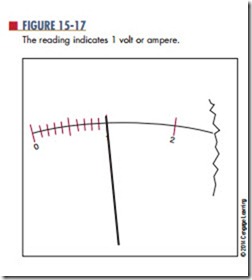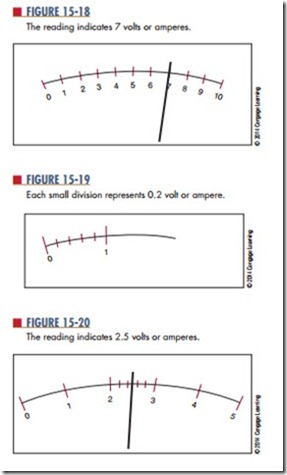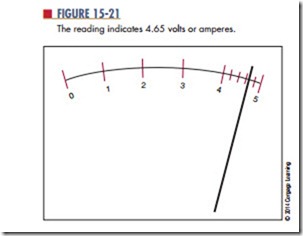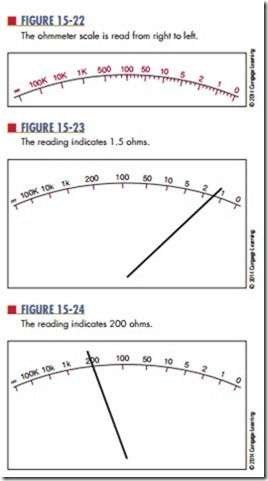reading Meter scales
Voltmeter and ammeter scales are read in the same manner. However, voltmeters measure volts, and ammeters measure amperes. The maximum value indicated by a meter is called the full-scale value. In other words, the maximum voltage or current that a meter can read is its full-scale value.
The measured value of voltage or current is read on the scale under the pointer. For example, the pointer in Figure 15-17 is shown deflected one major division, indicating a voltage of 1 volt or a current of 1 ampere.
In Figure 15-18, the meter is shown deflected seven major divisions, indicating a current of 7 amperes or a voltage of 7 volts.
If the pointer of the meter rests between the major divisions of the scale, the smaller divisions are read.
Figure 15-19 shows four small lines between each major division of the scale, creating five equally spaced intervals. Each of these small intervals represents onefifth of the major interval, or 0.2 units.
If the pointer falls between the small lines on a meter scale, the value must be estimated. In Figure 15-20, the pointer falls between the 2⁄5 (0.4) and 3⁄5 (0.6) marks. This indicates a value of approximately 2.5 volts or amperes. In Figure 15-21, the pointer is one-fourth of the distance between the 3⁄5 (0.6) and 4⁄5 (0.8) marks. Each small interval represents 0.2. One-fourth of 0.2 is 0.05. Therefore, the pointer indicates a value of about 4.65 volts or amperes.
The number of major and minor divisions on a me- ter scale depends on the range of the voltage or current that the meter is designed to measure. In all cases, the value of the small intervals can be found by dividing the value of the major interval by the number of spaces it contains.
The ohm scale on a meter is different from most voltage and current scales (Figure 15-22). It is read from right to left instead of from left to right. Also, it is a nonlinear scale, so the number of small spaces be- tween the major intervals is not the same throughout the scale. Between 0 and 1 there are five small spaces, which equal 0.2 unit each. There are four intervals between 5 and 10, representing 1 unit each, and between each of these there is a minor division that represents 0.5 unit. Between the 50 and 100 marks are five small intervals, which each represent 10 units. Between 100 and 500, there are four small intervals, each representing 100 units. The last mark on the left is labeled infinity (∞). If the pointer deflects to this mark, the resistance is beyond the range of the meter. The pointer normally rests on the infinity mark when no resistance is being measured. Figure 15-23 shows the pointer deflected to 1.5 ohms. Figure 15-24 shows the pointer indicating 200 ohms.
Before an ohmmeter is used, the test leads are shorted together and the zero control is adjusted so the pointer rests on the zero mark. This calibrates the meter and compensates for battery deterioration.
Questions
1. What determines the maximum value an ana- log meter can measure?
2. What are the differences between an ohmmeter scale and a voltmeter or ammeter scale?
3. What is really being measured with an ammeter?
4. Estimate the reading of the voltmeter scales in Figure 15-25.
5. When an ohmmeter reads infinity (∞), what is being measured?
Related posts:
Incoming search terms:
- how to read ammeter scale
- what is value of each small division in ammeter
- scales read of ammeter
- three scale of ammeter reading
- value of one division of ammeter
- voltmeter 15 division
- scale readinmman meter
- scale reading in an ammeter
- scale meter in electrical
- meter scale measurement of voltmeter
- major division of the voltmeter
- how to read voltmeter scale between divisions
- how to read the ammeter in different scale
- how to read electrical meter with several scales
- how to read an ohmmeter scale
- how to read an ammeter scale
- full scale reading of volt meter
- elektrical scales
- electric meter reading Scale
- a meter characterized by the use of a pointer and a scale



